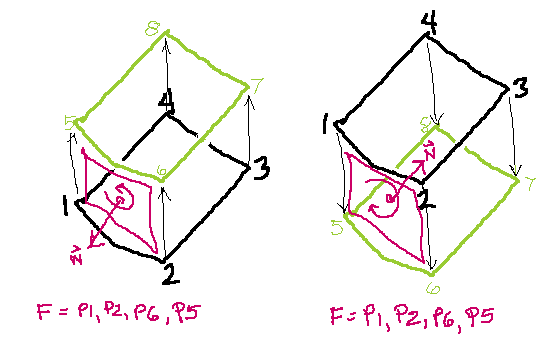TAPESTRY: The Art of Representation and Abstraction
Modeling Errors: geometric inversion
Inside-Out Geometry
The geometry of your shape consists of polygons. The polygons have an orientation, or direction in space, which is usually derived from (or expressed in) the order in which their vertices are stored in the database. In the example shown here, a rectangle is first extruded "up", yielding the desired results. Then, on the right, it is extruded "down". Applying exactly the same algorithm to the creation of the new data produces an inside-out piece of geometry, as illustrated in the figure.Here's that simple (and fallible) extrusion algorithm, in english.
- Replicate the points of the original perimeter, offset by some distance in space. If we started with a rectangle containing points P1, P2, P3, and P4, we would add points P5, P6, P7, and P8, mimicing the order of the original rectangle.
- Define the new faces as variations on F1=(P1,P2,P6,P5). A little messing around with the numbers and you'll see that F2 can be created by adding one to each of these, etc.
- Application of the Right-hand-rule to the new face will generate the appropriate surface normal.

The problem arises when the polygon is extruded in the opposite direction, or even if it's perimeter lists points in the oposite direction. Now the same logic, illustrated on the right side of the above figure, produces a geometry which faces IN, not OUT.
A less theoretical illustration might help. The following geometry was created in the form-Z application using the Revolve command. The torroidal object on the left should look quite odd, since the light reflected from it seems to come from a different direction than the rest of the model. In fact, the torus is inside-out. This has been corrected in the rendering on the right.


In form-Z the "Reverse Direction" tool (Row 10, Column 2) is used to reorient polygons in space. The fact that it exists should tell you something about how common this problem is. Make sure you apply it to the entire object!
Last updated: April, 2014
